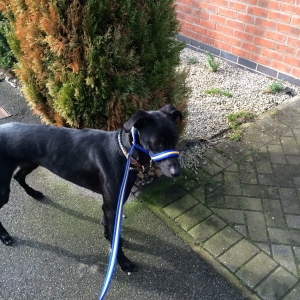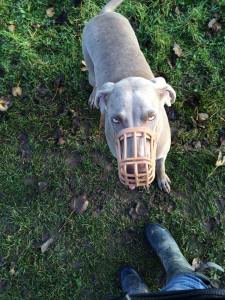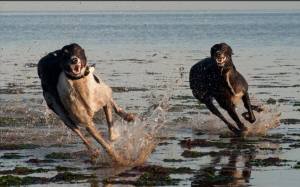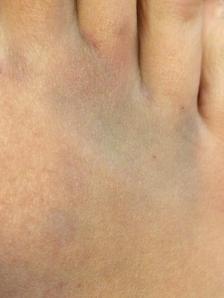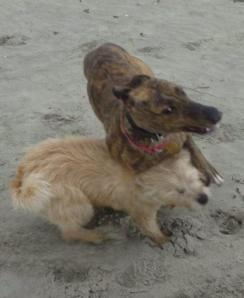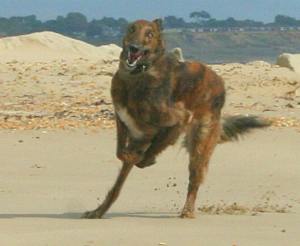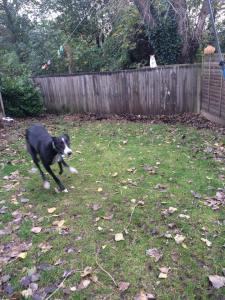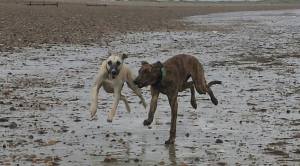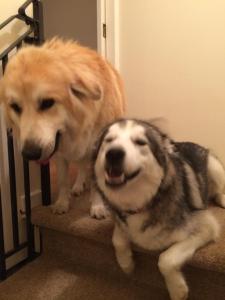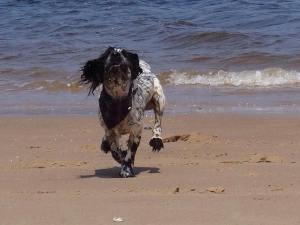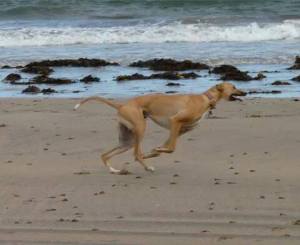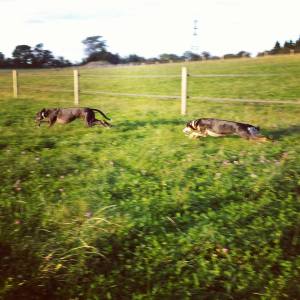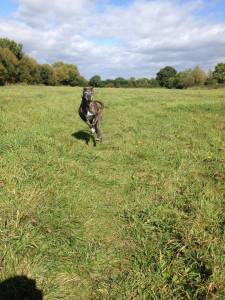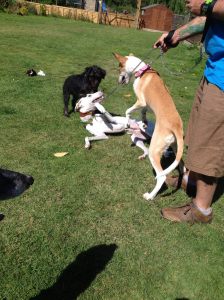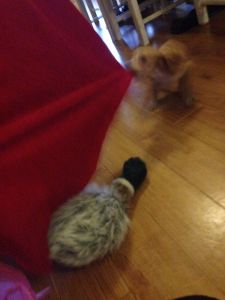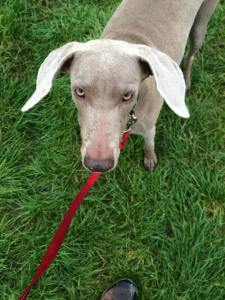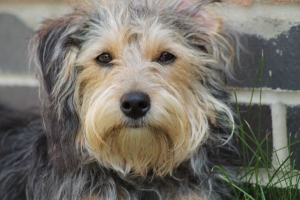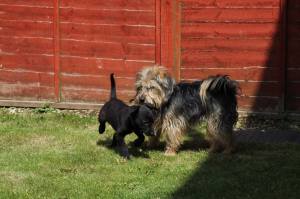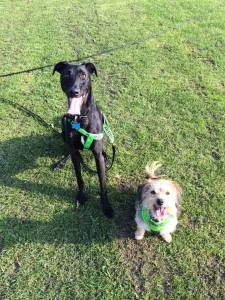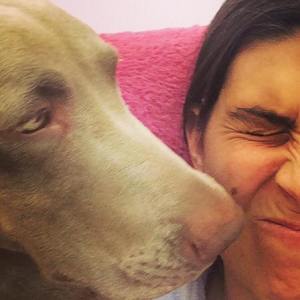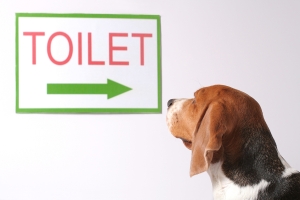
(Photo from Dog Instructor.com)
The most common question a new dog owner has – ‘How do I train him/her to go to the toilet outside?’
The answer: TIME.
Ok so it’s not that simple, but essentially time is the key. I’ve seen posts on facebook forums asking why their 9 week old puppy isn’t learning, despite trying ‘everything’. She’s 9 weeks old, her bladder isn’t capable of holding everything in for the 4 – 6 hours you’ve left her, or 10 hours overnight. Give her time. Same for a 14 week old, and even some 6 month olds – every dog takes a different amount of time, and some will be clean by 12 weeks, others like my yogi took 18 months + to be reliable. When you consider a puppies bladder is likely to be the size of a thimble, we ask an awful lot of them.
So here I lay out my tips to potty train. They are not fool proof or written in stone, find what works for you, your dog and your situation. I will confess to using a piece by Sally Bradbury and adapting it to my preferred method – so some of this may seem familiar to those that have read any of her work.
Toilet Training – Adapted from a piece by Sally Bradbury
First thing to remember is that we do not want to teach the puppy that going to the toilet is bad, naughty or any other negative. All this does is make pup worried to toilet anywhere and can lead to all sorts of long term issues. NEVER tell your dog off for going to the toilet inappropriately. NEVER use force or punishment, the old rolled up newspaper trick is not effective and cruel.
Look at the body language in this picture, what do you see?
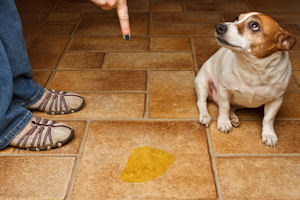
(photo from dog boarding surrey)
The dog is not ‘ashamed’ or ‘guilty’ but scared of the owners body language and presumably voice. Not the relationship you want with your pup. The method outlined below will help you get what you want (a potty trained dog) and help build the bond with your pup long term.
What we want to do is let puppy (or adult dog) know that its best to wee outside, and the best way to do that is constistant routine and watching pup like a hawk!
When you first get your pup, introduce this routine immeadiatley – if you have a confident pup or older dog, go directly to the back yard / garden and get a first toilet there – don’t force a very young pup to meet the big outside world straight away though.
Once your pup is ready you need to be prepared to take your puppy to the garden:
As soon as they wake from a big sleep or even a short nap.
After eating.
After taking a drink.
Before, during andare.
Before you go out.
Before bedtime
At least once per night (I usually do a 12am and 3am run for the first week or so) – you can extend this as the weeks go on.
And then at least once every twenty minutes in between unless they are asleep. During periods of activity change that to every ten to twenty minutes.
If you find that you are getting accidents in between, then shorten it to every fifteen minutes, then to ten if needed. Set an alarm so you don’t forget!.
Make going outside fun, I usually use a high, fun voice saying ‘outside for wee-wees’ – you need to distinguish that you want a specific action, you are not going out to play. Stay outside with your pup. Do not nag or distract him, or try to engage in play – just mooch about and he will do the same and eventually eliminate. Do not stay outside for more than 5 minutes. If he has not toiletted, bring him in calmly and wait inside for 5 minutes, watching for signs that he might toilet (sniffing, circling, squatting) then repeat the process outside – you need him to work out what you are going out for, letting him wander around for 20 mins isn’t helping the connection. When he does toilet you can chose your reward – some say that quiet praise is sufficient, others use a food reward, I prefer a lot of excitable praise – but again, find what you like to do. Once pup has eliminated, you can either stay out or go back indoors. If you stay out make sure you engage in a game or something fun – changing the tone of the garden time. Don’t forget if you do stay out he may need another toilet before going in, so praise if he initiates it on his own, or take him out five minutes after the game is finished.
If you miss a beat and see him start to toilet in the house, don’t panic – try your ‘outside’ cue to see if he’ll come out with you. If he’s already started, ignore him and go outside waiting for him to join you when he’s finished. If he’s not started the lift him and take him outside, using you cue all the time. Do not tell him off.
If your puppy toilets in the house and you’ve not seen him do it – it is because you haven’t toilet trained him yet and didn’t take him outside when he needed to go. When this happens take a rolled up newspaper and hit yourself over the head whilst repeating the words “I forgot to watch my puppy. I forgot to watch my puppy” If your puppy laughs at you when you do this – praise him.
Seriously – just think, oops – must do better, and clean the mess up with little fuss. If you can do so with pup elsewhere, even better. Use biological washing powder or a pet specific cleaner – nothing with bleach in as it smells like urine and will encourage him to go there again.
If you use a crate or puppy pen, take pup straight out of the crate to the garden and follow the guidelines above, some say crates make toilet training easier, some say that the use of them is lazy, personally I like them, but don’t think they are a replacement for patience and consistency!
Common mistakes during toilet training.
Using newspaper or puppy training pads. Whilst it may aid the clearing up process it can be very confusing for the pup that is taught or permitted to toilet in the house to make the transition to going outside and will often result in a pup that when playing in the garden will simply hold on until they are back indoors because that is where the toilet is.
Leaving the door open. This does nothing to teach the pup to toilet outside only – it removes the ‘inside / outside’ separation and doesn’t encourage bladder control. A dog that can go outside whenever it feels the urge, doesn’t learn to hold it.
Expecting your pup to tell you when he needs to go out. Once a pup understands that outside is where the toilet is then he may start to let you know he needs out. But for starters you need to set the pace!
Giving your pup an en suite in his crate. Do not encourage your pup to toilet in his crate by putting puppy pads in there. If you have to leave puppy for a while and he is going to need to go then best to have the crate inside a larger pen or blocked off area and leave the crate door open so that he can get away from his bed to toilet.
N.B. Areas indoors where pup has had an accident are best cleaned with a dilute of biological washing powder. Avoid using disinfectant as this contains ammonia and can encourage pup to pee there again.
Why punishment does not work for house training.
A typical morning in the life of an 8 week old pup.
7:00am Puppy pees in the garden – Owner present. Gets praised
7.30am Puppy pees in the kitchen – Owner present. Gets a reprimand
8:15am Puppy pees in the lounge – Owner not present. Nothing happens except relief
9:00am Puppy pees in the lounge – Owner present. Gets a reprimand
9:30 am Puppy pees in the kitchen – Owner not present. Nothing, just relief
11:00am Puppy pees in the garden – Owner doesn’t notice Just relief again
11:30am Puppy pees under the dining room table – Owner not present. Nothing happens
12:15pm Puppy pees in the garden – Owner present – gets praise
What we think we are teaching puppy is that it is good to pee in the garden and wrong to pee in the house but what the pup is actually learning is that sometimes it is rewarding to pee when the owner is present and sometimes it is dangerous. However it is always safe to go when the owner is not present and that so far the safest place is under the dining room table.
Never deny your dog water in the mistaken belief that this will aid toilet training. It won’t. It will make the urine stronger, it may impact on your dog’s health, i.e. cause kidney problems or urinary tract infections.if the dog drinks greedily and excessively when it is available knowing it will be taken away. Dogs must have clean fresh water available all of the time.

